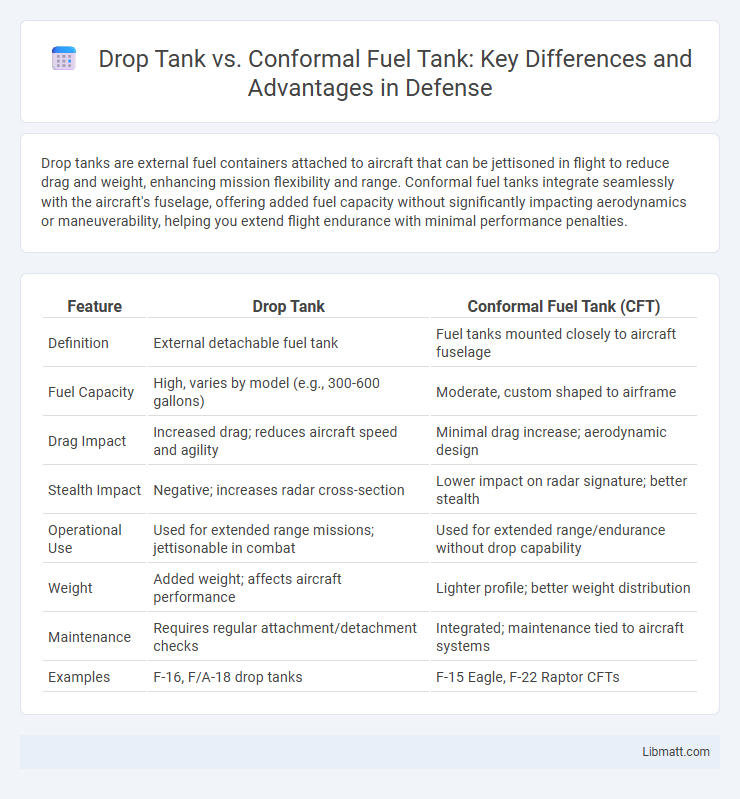Drop tanks are external fuel containers attached to aircraft that can be jettisoned in flight to reduce drag and weight, enhancing mission flexibility and range. Conformal fuel tanks integrate seamlessly with the aircraft's fuselage, offering added fuel capacity without significantly impacting aerodynamics or maneuverability, helping you extend flight endurance with minimal performance penalties.
Table of Comparison
| Feature | Drop Tank | Conformal Fuel Tank (CFT) |
|---|---|---|
| Definition | External detachable fuel tank | Fuel tanks mounted closely to aircraft fuselage |
| Fuel Capacity | High, varies by model (e.g., 300-600 gallons) | Moderate, custom shaped to airframe |
| Drag Impact | Increased drag; reduces aircraft speed and agility | Minimal drag increase; aerodynamic design |
| Stealth Impact | Negative; increases radar cross-section | Lower impact on radar signature; better stealth |
| Operational Use | Used for extended range missions; jettisonable in combat | Used for extended range/endurance without drop capability |
| Weight | Added weight; affects aircraft performance | Lighter profile; better weight distribution |
| Maintenance | Requires regular attachment/detachment checks | Integrated; maintenance tied to aircraft systems |
| Examples | F-16, F/A-18 drop tanks | F-15 Eagle, F-22 Raptor CFTs |
Introduction to Aircraft Fuel Tanks
Aircraft fuel tanks, including drop tanks and conformal fuel tanks, enhance operational range and mission flexibility. Drop tanks are externally mounted, detachable fuel containers that increase fuel capacity for extended flights and can be jettisoned when empty or during combat. Conformal fuel tanks fit closely to the aircraft's fuselage, minimizing drag while providing additional fuel without compromising aerodynamic efficiency, allowing your mission to benefit from extended endurance and optimized performance.
What is a Drop Tank?
A drop tank is an external fuel container attached to an aircraft to extend its flight range by carrying additional fuel. Designed for quick jettisoning, drop tanks improve mission flexibility by reducing drag and weight once their fuel is depleted or during combat. These tanks are typically mounted under wings or fuselage and are widely used in military aviation for long-range operations.
What is a Conformal Fuel Tank?
A Conformal Fuel Tank (CFT) is an external fuel storage system designed to fit closely along the contours of an aircraft's fuselage or wings, minimizing aerodynamic drag and preserving maneuverability. Unlike drop tanks, which are detachable and jettisoned when empty or in combat, CFTs are permanently attached, providing extended range without significantly compromising stealth or performance. These tanks enhance mission endurance by increasing fuel capacity while maintaining low radar cross-section characteristics critical for modern fighters.
Design Differences: Drop Tank vs Conformal Fuel Tank
Drop tanks are external fuel containers attached to the aircraft's wings or fuselage, designed for easy jettisoning during combat or emergencies, significantly increasing range without permanently altering the aircraft's structure. Conformal fuel tanks (CFTs) integrate smoothly with the aircraft's surface, reducing aerodynamic drag and preserving maneuverability while providing additional fuel capacity without occupying hardpoints. Your choice between drop tanks and conformal fuel tanks depends on mission profile priorities, balancing fuel capacity, aerodynamic efficiency, and operational flexibility.
Installation Methods and Aircraft Compatibility
Drop tanks are externally mounted under the wings or fuselage using pylons, allowing quick installation and removal compatible with various fighter jets like the F-16 and F/A-18. Conformal fuel tanks (CFTs) attach seamlessly along the aircraft's fuselage, designed for specific models such as the F-15E and F-22, enhancing aerodynamics without occupying hardpoints. Your choice between drop tanks and CFTs depends on operational needs and the specific aircraft's compatibility with these installation methods.
Aerodynamic Impact and Performance
Drop tanks increase drag due to external mounting, which can reduce the aircraft's speed and maneuverability, especially at higher speeds. Conformal fuel tanks (CFTs) are designed to fit closely along the aircraft's fuselage, minimizing aerodynamic disruption and preserving stealth characteristics while extending range. The integration of CFTs enhances overall performance by maintaining cleaner airflow compared to the bulkier, drag-inducing drop tanks.
Operational Flexibility and Mission Adaptability
Drop tanks offer enhanced operational flexibility by allowing aircraft to jettison fuel tanks when entering combat zones, improving maneuverability and reducing weight quickly. Conformal fuel tanks (CFTs) improve mission adaptability by increasing fuel capacity without significantly impacting aerodynamic performance or radar cross-section, enabling longer missions without external stores. Balancing your mission needs between the quick discard capability of drop tanks and the streamlined endurance of CFTs can optimize overall combat effectiveness.
Maintenance and Safety Considerations
Drop tanks require regular inspections to ensure attachment points and fuel lines remain secure and leak-free, posing potential safety risks if not properly maintained. Conformal fuel tanks integrate seamlessly with the aircraft's structure, simplifying maintenance by reducing external components vulnerable to damage and minimizing aerodynamic drag that can affect handling safety. Your choice between these tanks impacts maintenance workload and operational safety, with conformal tanks generally offering enhanced reliability and reduced inspection complexity.
Cost-Benefit Analysis
Drop tanks offer a lower upfront cost and enhanced flexibility by allowing pilots to jettison fuel tanks when needed, reducing weight and drag during combat or high-performance maneuvers. Conformal fuel tanks, while more expensive and integrated into the aircraft's structure, provide improved aerodynamics and sustained fuel efficiency without significantly impacting performance or requiring pilot intervention. Your choice depends on mission priorities: drop tanks for cost-effective, short-term fuel extension versus conformal tanks for long-term operational efficiency and lower drag penalties.
Choosing Between Drop Tank and Conformal Fuel Tank
Choosing between a drop tank and a conformal fuel tank depends on your aircraft's mission profile and performance needs. Drop tanks offer increased fuel capacity and can be jettisoned to reduce weight and drag during combat or high-speed maneuvers, while conformal fuel tanks integrate smoothly with the airframe, minimizing aerodynamic penalties and improving stealth capabilities. Your decision should weigh factors like mission duration, maneuverability requirements, and the importance of stealth or external store management.
drop tank vs conformal fuel tank Infographic

 libmatt.com
libmatt.com